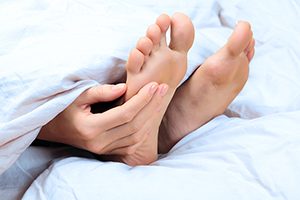Arthritis
Ankle Arthritis
Ankle arthritis involves inflammation of the joints and most commonly occurs due to aging. As we age, the cartilage that cushions the bones gradually wears away and leaves the bone ends uncovered, causing symptoms to develop.
Patients with ankle arthritis may not initially experience any symptoms. As the condition progresses, symptoms may include pain, stiffness, swelling, instability, bone spurs, joint deformity and difficulty walking. If the nerves surrounding the joint become irritated, patients may experience numbness and tingling.
Hindfoot Arthritis
Hindfoot arthritis involves pain and stiffness in the joints at the rear of the foot. There are several surgical options that may be used to relieve the symptoms and restore function to the area.
Triple arthrodesis is a procedure used to fuse the talonavicular, subtalar and calcaneal joints. This surgery has a long recovery period and is used only in severe cases. The damaged cartilage is removed from the area, bone is grafted onto the joint and the foot is positioned with screws and plates for stability.
Subtalar joint arthrodesis is often the best procedure for those in whom hindfoot arthritis has resulted in a heel fracture or acquired flatfoot deformity. In this surgery, any cartilage remaining between the heel and talus bone is removed, the bone is trimmed back and the joint is held in the correct position with screws and sometimes a bone graft.
Talonavicular joint arthodesis is a procedure successful in reducing the symptoms of arthritis in that joint such as aching pain upon walking or standing. This surgery involves fusing the talonavicular joint together with screws and sometimes a bone graft.
Midfoot Arthritis
When arthritis is present in the midfoot, there is usually resultant pain in the area when standing or walking. It is often at its worst when first standing up after sitting or lying down.
Treatment of midfoot arthritis usually entails resting the foot, taking nonsteroidal anti-inflammatory medication, wearing supportive shoes and using a cane or crutches. Weight loss may be recommended to reduce the burden on the foot. If these therapies are unsuccessful, a midfoot fusion surgery may be needed to reduce pain in the area.
Forefoot Arthritis

Mild cases of hallux rigidus can often be treated with over-the-counter painkillers, orthotics, physical therapy or injections, while surgery may be necessary for more severe cases.
Freiberg’s infraction is a disorder that causes pain and stiffness in the forefoot that often worsens with activity. It is most common in adolescent girls. The cause is unknown, but Freiberg’s infraction often begins after trauma takes place to the foot. The blood supply to the second metatarsal bone may be disrupted, causing bone cells to die off.
Resting the foot, physical therapy, supportive shoes and orthotics can all help relieve the symptoms of Freiberg’s infraction.
Rheumatoid Arthritis
Patients with rheumatoid arthritis in the feet are at an increased risk of developing bunions, metatarsalgia and hammertoes. These conditions result from joint inflammation, loosening of the ligaments and capsule lining and a degeneration of cartilage in the joint. Patients with these conditions often have difficulty walking and wearing shoes as inflammation increases.
Treatment of forefoot deformities varies depending on the type and severity of the condition, but aims to relieve pain and restore the normal appearance and alignment of the foot. Conservative treatments may include modifying your shoes or wearing orthotics. However, most patients will need to undergo surgery. Surgery for rheumatoid forefoot deformities may involve the Hoffman procedure, joint fusion or osteotomy of the metatarsals.
Contact Us
Ladera Ranch
333 Corporate Dr. Ste 230, Ladera Ranch, CA 92694
Tel: (949) 364-9255 (WALK)
Fax: (949) 364-9250
Office Hours:
Monday - Friday: 9am - 5pm
*(Lunch 12 noon - 1pm)
Orange
2617 E Chapman Ave, Orange, CA 92694
Tel: (714) 639-7993
Fax: (714) 639-0729
Office Hours:
Monday - Friday: 9am - 5pm
*(Lunch 12 noon - 1pm)
